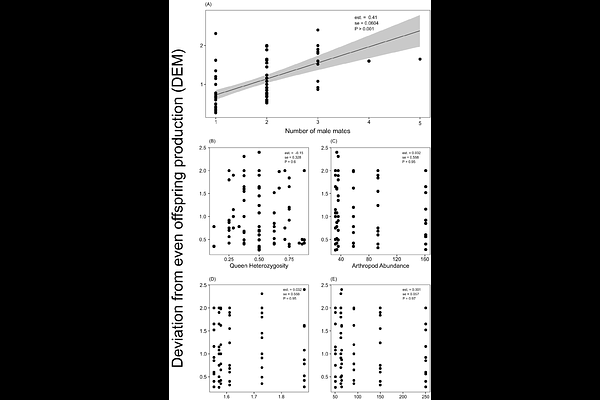Multiple mating predicts queen reproductive output in the polygynous Neotropical trap-jaw ant, Odontomachus chelifer (Formicidae: Ponerinae)

Multiple mating predicts queen reproductive output in the polygynous Neotropical trap-jaw ant, Odontomachus chelifer (Formicidae: Ponerinae)
Florindo, H. S.; Azevedo-Silva, M.; Romeiro, M.; Pereira de Souza, A.; Oliveira, P. S.; Mori, G. M.
AbstractThe factors that influence the organisms\' ability to reproduce are diverse. In ants, social structure may contribute to queens\' Reproductive Output (RO), alongside environmental conditions and genetic attributes. Polygynous species like the Neotropical trap-jaw ant, Odontomachus chelifer, are valuable biological systems to investigate the contribution of these factors to the RO of queens. We hypothesize that O. chelifer queens\' RO increases with (1) higher multiple mating (polyandry) per queen; (2) higher queen heterozygosity; (3) greater food availability. We sampled workers from 18 colonies from the Brazilian Cerrado savanna (15 workers per colony) and used eight microsatellites to infer the number of male mates per queen, queens\' heterozygosity, and the proportion of offspring produced per queen. The latter was used to calculate the index of deviation from even offspring production (DEM) among queens. Arthropod communities from sampling sites were used as a proxy for food resources availability. We evaluated the relationships between DEM and the predictor variables using bivariate generalized linear models. Our results showed a positive relationship between polyandry and DEM (Coefficient = 0.41, P < 0.001). It suggests that the number of male mates likely benefits queen productivity, highlighting the role colony structure plays in the fitness of individual queens within O. chelifer colonies. Our findings did not support the remaining hypotheses. This work illuminates the role of social forms in evolutionary processes in ants, making way for similar studies in different social insects and contributes to a better understanding of the reproductive traits of trap-jaw ants.